Answer these simple questions and we will find you the BEST prices
Which type of solar quotes do you need?
It only takes 30 seconds
100% free with no obligation

Get Free quotes from insulation specialists near you

Save money by comparing quotes and choosing the most competitive offer

The service is 100% free and with no obligation
- GreenMatch
- Insulation
- Ceiling Insulation
- Vaulted Ceiling Insulation
How to Insulate a Vaulted Ceiling in the UK (2025)

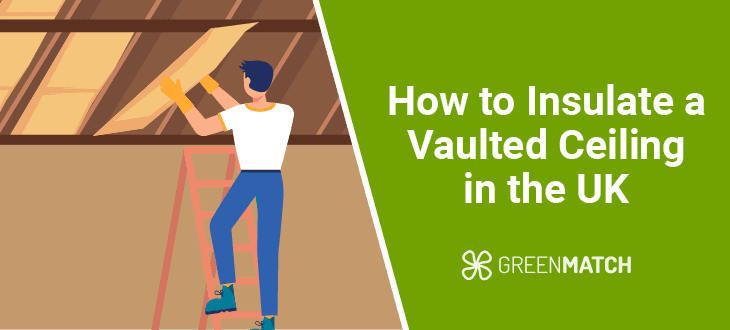
- Insulating a vaulted ceiling can reduce your annual energy bills by £270 to £445.
- UK building regulations for insulating a vaulted ceiling require a maximum U-value of 0.20 W/m²K, typically meaning the insulation should be 100 to 150mm thick.
- Spray foam insulation is considered the best overall material, offering exceptional thermal efficiency and airtightness while reaching difficult areas in a vaulted ceiling.
Insulating a vaulted ceiling in the UK is crucial to enhancing your home’s energy efficiency and comfort. Proper insulation can lead to significant savings on energy bills, with well-insulated homes seeing yearly reductions between £270 and £445. Beyond cost savings, insulation contributes to a more sustainable living environment by reducing carbon emissions by 0.6 tonnes per year.
With their high, sloping design, vaulted ceilings create stunning, open spaces. Still, they are also prone to heat loss if not insulated correctly. Whether you are constructing a new home or retrofitting an existing one, effective insulation can lower your heating costs, minimise drafts, and even increase the overall value of your property.
However, insulating a vaulted ceiling is more complex than insulating a flat ceiling. It requires careful attention to the choice of materials, proper ventilation, and compliance with UK building regulations. This guide will explore the best methods for insulating a vaulted ceiling in the UK, ensuring your home stays comfortable and energy-efficient throughout the year. From selecting the right insulation materials to understanding necessary regulations and installation techniques, this article will equip you with the knowledge needed to achieve the best results.
Ready to insulate your vaulted ceiling and enjoy all the benefits that come with it? GreenMatch UK is here to help. We can provide up to four free quotes from top insulation specialists in your area, ensuring the project is tailored to your needs and budget. Fill out our quick 30-second form to get started. Click below to learn more!
- Describe your needs
- Get free quotes
- Choose the best offer
It only takes 30 seconds



How to insulate a vaulted ceiling
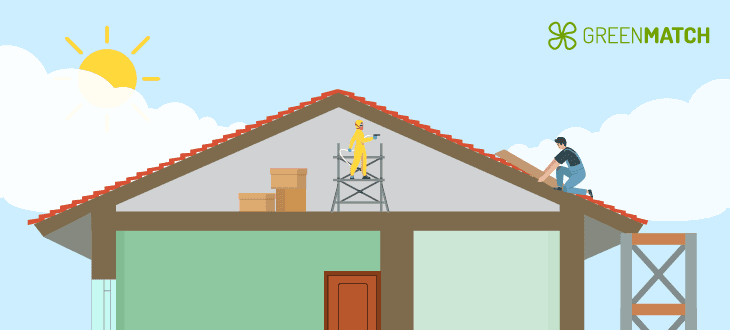
Insulating a vaulted ceiling can be challenging, much like pitched roof insulation, due to the sloping design that rises to a peak. However, despite the complexity and time investment, a properly insulated vaulted ceiling offers significant benefits—lower energy bills, improved comfort, and a reduced carbon footprint. This is why it's crucial to understand the various methods available for insulating a vaulted ceiling effectively.
Here are the main methods for insulating a vaulted ceiling:
- Cold roof insulation: This approach is suitable for vaulted ceilings with no rooms above, as it involves adding insulation on top of the roof structure before the final roofing material is installed. Cold roof insulation lets you expose the rafters, offering aesthetic appeal and good thermal comfort. However, it usually requires re-roofing, which can be costly. Additionally, weather conditions can affect the timeline, and you may need to replace tiles if there is any break during the process.
- Warm roof insulation: The most common method for insulating a vaulted ceiling, especially in existing homes, is adding insulation between or below the rafters inside the ceiling structure. It is typically more accessible and affordable than cold roof insulation since it doesn’t interfere with the external roof and can be used for vaulted ceilings with rooms above.
With warm roof insulation, you have two options: exposing the rafters or covering them. Keeping the rafters exposed is the more expensive choice, as it requires careful installation to maintain an airtight seal while leaving the rafters visible. On the other hand, covering the rafters is more cost-effective and quicker to install. This involves filling the ceiling with bulk insulation and then covering it with plasterboard or lining boards for a neat finish.
Steps for sloping ceiling insulation
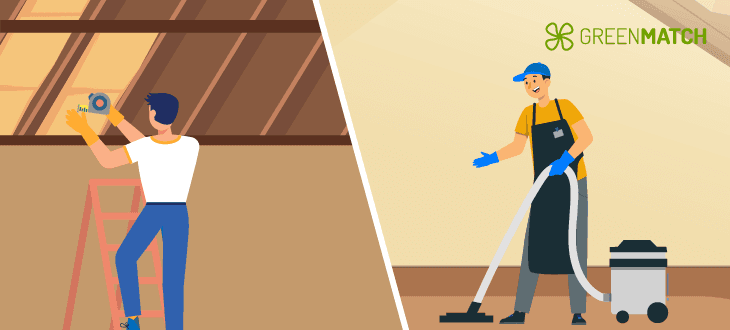
Once you've decided on the best method for insulating a vaulted ceiling, it's essential to understand the key steps for installing insulation on a sloping ceiling.
- Measure the space: Use a measuring tape to determine the dimensions between the rafters. Multiply this amount for each space that needs insulation.
- Prepare the area: Make sure the space is clear and accessible. Remove any existing ceiling coverings if necessary to expose the rafters.
- Check ventilation: Install baffles or vent chutes to ensure proper airflow between the insulation and the roof deck, preventing moisture buildup and condensation.
- Choose insulation: Decide on the type of insulation (e.g., fibreglass batts, rigid foam, or spray foam) based on your needs.
- Install the insulation: Fit the insulation between the rafters. Cut them to size with a sharp knife for materials like fibreglass batts, mineral wool, or rigid foam boards. Professional installation is necessary for spray foam.
- Insulate around fixtures: Cut insulation to fit around electrical outlets and light fixtures, ensuring no gaps. Fire-resistant materials or those treated with fire retardant should be used, as these areas can be fire hazards.
- Seal gaps: Apply sealant to close any gaps around the insulation to prevent air leakage.
- Cover the rafters: If you're not leaving the rafters exposed, cover them with plasterboard or lining to finish the look.
DIY insulation for a vaulted ceiling is possible but complex and time-consuming, with poor installation potentially causing costly issues like condensation. To avoid this, consulting an insulation specialist is essential. Comparing quotes from multiple specialists is recommended, but the process can take time. GreenMatch simplifies this by offering up to four free quotes from trusted local specialists. Just fill out our 30-second form to get started. Click below to learn more.
- Describe your needs
- Get free quotes
- Choose the best offer
It only takes 30 seconds



Requirements for vaulted ceiling insulation in the UK
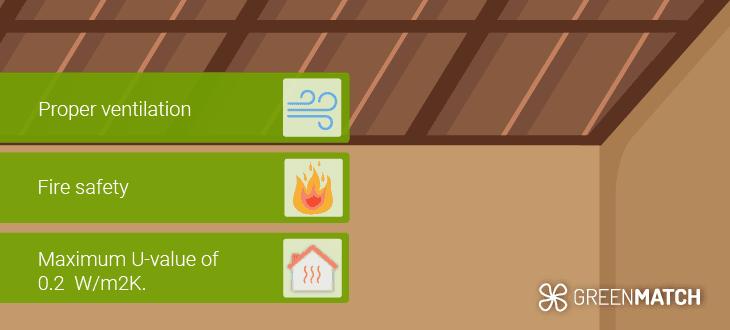
When insulating a vaulted ceiling in the UK, it’s crucial to meet specific building regulations to ensure energy efficiency, proper ventilation, and fire safety.
Vaulted ceiling insulation must comply with UK Building Regulations Part L, which focuses on energy conservation. The insulation should achieve a U-value of no more than 0.20 W/m2K. To meet this standard, the thickness of roof insulation typically ranges from 100 to 150mm between the rafters and around 40mm over the rafters, depending on the material’s R-value—a higher R-value means less thickness may be required.
Proper ventilation is crucial in preventing condensation and moisture buildup, which can lead to mould growth and structural damage. In the case of vaulted ceilings, it's essential to create 50mm ventilation gaps between the insulation and the roof deck to ensure adequate airflow and reduce the risk of moisture accumulation.
Fire safety is another important factor to consider. All insulation materials must comply with fire safety regulations, and in some cases, additional fire-retardant coverings like plasterboard may be required to protect the insulation in the event of a fire.
While most insulation projects fall under permitted planning, it’s important to check if a planning permit is necessary, especially if your home is located in a conservation area or has protected status. This is particularly relevant when insulating a vaulted ceiling with historic or aesthetic features like exposed wooden beams, as covering them may not be allowed, limiting your insulation options.
By following these guidelines, you ensure that your vaulted ceiling is energy-efficient, reducing heat loss and improving comfort while staying compliant with UK building regulations. Proper insulation not only enhances the thermal performance of your home but also increases safety and adds value by adhering to both energy and fire safety standards.
What is the best way to insulate a vaulted ceiling?
When choosing insulation for your ceiling, you should consider factors such as the design of the ceiling, your budget, and your energy efficiency goals. Different methods and materials provide varying insulation performance levels, so choosing the right approach based on your needs is essential. Here are the two top recommendations, one focused on performance and the other on budget.
Best for performance: Spray foam
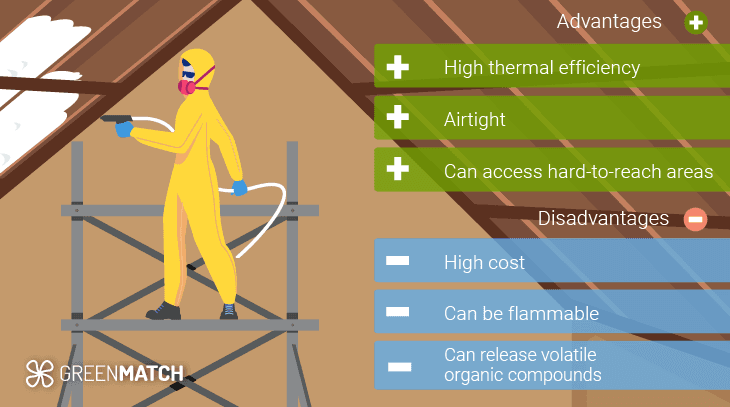
If energy efficiency is your top priority, spray foam insulation is an excellent choice for insulating a vaulted ceiling. This method provides superior thermal resistance (R-value) and airtightness performance, reducing energy loss and maintaining a consistent indoor temperature.
Spray foam expands to fill every gap, eliminating drafts and preventing thermal bridging, making it ideal for maximising energy efficiency. The R-value of spray foam ranges from 3.6 to 7 per inch, depending on whether you choose open-cell or closed-cell foam. Open-cell spray foam has an R-value of 3.6 to 3.9 per inch, while closed-cell spray foam offers a higher R-value of 6 to 7 per inch. Its expanding properties suit vaulted ceilings, ensuring a complete, airtight seal even in hard-to-reach areas.
However, there are significant drawbacks to consider. Spray foam is one of the more expensive insulation options, with open-cell spray foam costing approximately £55 per m2, and closed-cell at around £70 per m2. Additionally, spray foam can release volatile organic compounds (VOCs) and isocyanates, which may pose health risks if improperly handled. Homes must be vacated for 24 hours during the curing process. Another concern is its flammability; in the event of a fire, spray foam can spread flames and release toxic chemicals, so proper fire safety precautions are essential.
Best for budget: Fibreglass
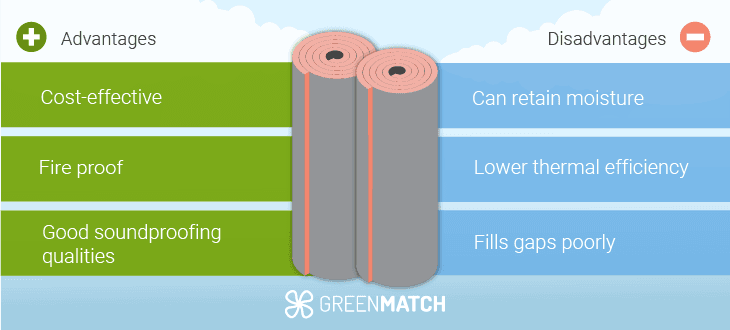
For a more budget-friendly option, fibreglass batts are a cost-effective choice for insulating a vaulted ceiling. Widely available and easy to install, fibreglass batts provide good insulation when fitted adequately between the rafters, making them ideal for those on a budget. Fibreglass is popular due to its low cost, averaging around £10 per m2, and it comes in blankets (batts) or as loose fill. Made of glass fibres, fibreglass is fire-resistant, withstanding temperatures up to 540°C, which won’t contribute to spreading fire in your home. Additionally, it offers excellent soundproofing properties.
Fibreglass insulation has an R-value of 3 to 4 per inch, providing decent thermal performance. While fibreglass doesn’t absorb water, it can retain moisture, reducing its insulating effectiveness and R-value, potentially leading to mould and mildew growth. Fibreglass is also less effective at preventing air leaks and may not perfectly fill every gap.
Ultimately the choice on which vaulted ceiling insulation material you choose depends on how much you're willing to invest upfront and your long-term energy savings goals.
Benefits of sloping ceiling insulation
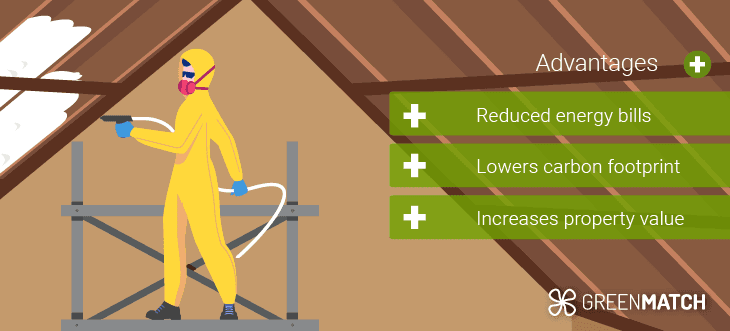
Insulating a vaulted ceiling offers several key benefits that can significantly improve your home's comfort, energy efficiency, and value. Here are the main advantages:
- Improved energy efficiency: One of the primary benefits of insulating a vaulted ceiling is reducing heat loss. Adding heat insulation can significantly lower energy consumption, keeping your home warmer in winter and cooler in summer. This leads to reduced heating and cooling costs over time.
- Enhanced comfort: Proper insulation creates a more consistent indoor temperature, eliminating drafts and cold spots that can occur with uninsulated or poorly insulated vaulted ceilings.
- Reduced carbon footprint: By improving insulation in your vaulted ceiling, you reduce the energy needed to heat or cool your home, lowering your overall carbon emissions and contributing to environmental sustainability.
- Soundproofing: Insulating a vaulted ceiling can also improve soundproofing, reduce noise transmission between rooms or external sources, and make your home quieter and more comfortable.
- Moisture control: Good insulation helps prevent moisture buildup and condensation, which can lead to issues like mould and mildew. Properly installed insulation, along with adequate ventilation, will protect the structural integrity of your ceiling.
- Increased property value: A well-insulated vaulted ceiling can also increase the value of your home, as energy-efficient homes are more appealing to potential buyers due to lower running costs and improved comfort. For maximum thermal efficiency, consider combining vaulted ceiling insulation with roof insulation to enhance your home's saving potential further.
To fully enjoy these benefits, it's vital to have the insulation installed correctly. Working with a skilled insulation specialist ensures proper installation and long-term performance. To find the best specialist for your needs, comparing multiple quotes is essential, ensuring you get quality work within your budget.
With GreenMatch UK, you can easily receive up to four free quotes from trusted local insulation professionals, making it simple to find the right expert to handle your vaulted ceiling or roof insulation project. Fill out our 30-second form to get started today! Click below to learn more.
- Describe your needs
- Get free quotes
- Choose the best offer
It only takes 30 seconds



FAQ
To insulate a sloped ceiling, you typically install insulation between the rafters, ensuring proper ventilation and sealing any gaps to prevent air leakage.
To keep a room with a vaulted ceiling warm, use high-quality insulation, ensure airtightness, and consider using heating systems that distribute heat evenly throughout the space.
In the UK, vaulted ceiling insulation must meet building regulations requiring a maximum U-value of 0.20 W/m²K and proper ventilation to prevent condensation.
The best way to insulate a vaulted ceiling is by using spray foam insulation for its superior thermal efficiency and ability to seal hard-to-reach areas.

Caoimhe is an experienced content writer and researcher who is passionate about providing accessible information to every reader. With a background in English literature and Sociology, she combines the two disciplines to create cohesive, well-thought-out, and well-informed pieces.
We strive to connect our customers with the right product and supplier. Would you like to be part of GreenMatch?

- Describe your needs
- Get free quotes
- Choose the best offer
It only takes 30 seconds



